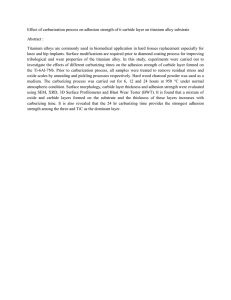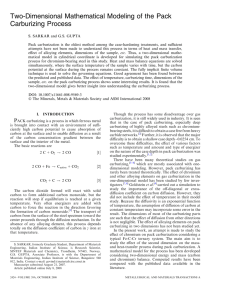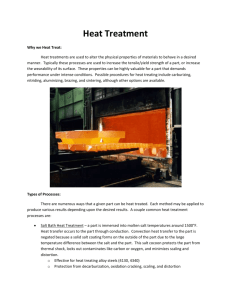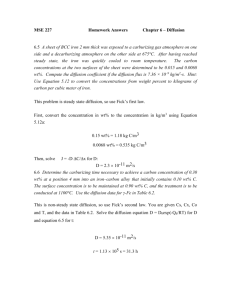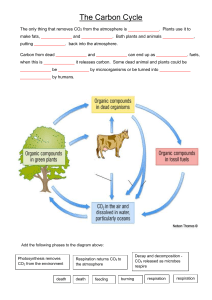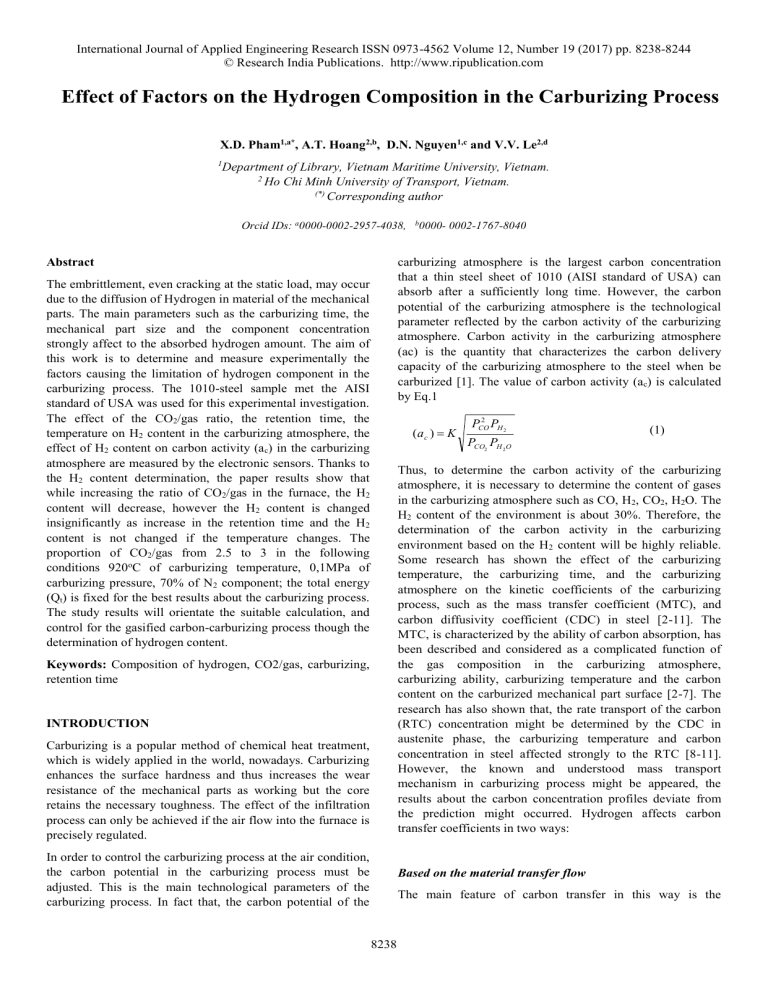
International Journal of Applied Engineering Research ISSN 0973-4562 Volume 12, Number 19 (2017) pp. 8238-8244 © Research India Publications. http://www.ripublication.com Effect of Factors on the Hydrogen Composition in the Carburizing Process X.D. Pham1,a*, A.T. Hoang2,b, D.N. Nguyen1,c and V.V. Le2,d Department of Library, Vietnam Maritime University, Vietnam. 2 Ho Chi Minh University of Transport, Vietnam. (*) Corresponding author 1 Orcid IDs: a0000-0002-2957-4038, b0000- 0002-1767-8040 carburizing atmosphere is the largest carbon concentration that a thin steel sheet of 1010 (AISI standard of USA) can absorb after a sufficiently long time. However, the carbon potential of the carburizing atmosphere is the technological parameter reflected by the carbon activity of the carburizing atmosphere. Carbon activity in the carburizing atmosphere (ac) is the quantity that characterizes the carbon delivery capacity of the carburizing atmosphere to the steel when be carburized [1]. The value of carbon activity (a c) is calculated by Eq.1 Abstract The embrittlement, even cracking at the static load, may occur due to the diffusion of Hydrogen in material of the mechanical parts. The main parameters such as the carburizing time, the mechanical part size and the component concentration strongly affect to the absorbed hydrogen amount. The aim of this work is to determine and measure experimentally the factors causing the limitation of hydrogen component in the carburizing process. The 1010-steel sample met the AISI standard of USA was used for this experimental investigation. The effect of the CO2/gas ratio, the retention time, the temperature on H2 content in the carburizing atmosphere, the effect of H2 content on carbon activity (ac) in the carburizing atmosphere are measured by the electronic sensors. Thanks to the H2 content determination, the paper results show that while increasing the ratio of CO2/gas in the furnace, the H2 content will decrease, however the H2 content is changed insignificantly as increase in the retention time and the H2 content is not changed if the temperature changes. The proportion of CO2/gas from 2.5 to 3 in the following conditions 920oC of carburizing temperature, 0,1MPa of carburizing pressure, 70% of N2 component; the total energy (Qt) is fixed for the best results about the carburizing process. The study results will orientate the suitable calculation, and control for the gasified carbon-carburizing process though the determination of hydrogen content. (a c ) K 2 PCO PH 2 PCO2 PH 2O (1) Thus, to determine the carbon activity of the carburizing atmosphere, it is necessary to determine the content of gases in the carburizing atmosphere such as CO, H2, CO2, H2O. The H2 content of the environment is about 30%. Therefore, the determination of the carbon activity in the carburizing environment based on the H2 content will be highly reliable. Some research has shown the effect of the carburizing temperature, the carburizing time, and the carburizing atmosphere on the kinetic coefficients of the carburizing process, such as the mass transfer coefficient (MTC), and carbon diffusivity coefficient (CDC) in steel [2-11]. The MTC, is characterized by the ability of carbon absorption, has been described and considered as a complicated function of the gas composition in the carburizing atmosphere, carburizing ability, carburizing temperature and the carbon content on the carburized mechanical part surface [2-7]. The research has also shown that, the rate transport of the carbon (RTC) concentration might be determined by the CDC in austenite phase, the carburizing temperature and carbon concentration in steel affected strongly to the RTC [8-11]. However, the known and understood mass transport mechanism in carburizing process might be appeared, the results about the carbon concentration profiles deviate from the prediction might occurred. Hydrogen affects carbon transfer coefficients in two ways: Keywords: Composition of hydrogen, CO2/gas, carburizing, retention time INTRODUCTION Carburizing is a popular method of chemical heat treatment, which is widely applied in the world, nowadays. Carburizing enhances the surface hardness and thus increases the wear resistance of the mechanical parts as working but the core retains the necessary toughness. The effect of the infiltration process can only be achieved if the air flow into the furnace is precisely regulated. In order to control the carburizing process at the air condition, the carbon potential in the carburizing process must be adjusted. This is the main technological parameters of the carburizing process. In fact that, the carbon potential of the Based on the material transfer flow The main feature of carbon transfer in this way is the 8238 International Journal of Applied Engineering Research ISSN 0973-4562 Volume 12, Number 19 (2017) pp. 8238-8244 © Research India Publications. http://www.ripublication.com existence of the j-flow from the ambient environment to the steel surface. The dynamic of this process is that, there exists a boundary layer at the gas-solid separator interface, at which the carbon concentration in the environment ever-decreases to the steel surface [1]. The carbon transfer coefficient () depends mainly on the concentration of carburizing gas, and is given in Table 1. Thus, according to both viewpoints, the material transfer coefficient depends mainly on the carburizing temperature and concentration/content gas. At a specified carburizing temperature, the carbon transfer coefficient depends entirely on the carburizing concentration/ content gas. In particular, the carbon transfer coefficient depends very much on the H 2 content in the carburizing gas as well as the characteristics of carburizing environment. By studying the factors influence the H2 gas composition, the carburizing process will be determined and controlled in order to ensure the optimum performance. Therefore, study of the factors affecting the composition of hydrogen gas in the carburizing environment in case of gasified carbon is an urgent requirement and will be carried out in this work. Table 1. The carbon transfer coefficient with different carburizing gas [4] Carburizing gas Ratio CO:H2 β [cm/s.10-7] CO+CO2 99/0 0.54 Methanol+CH4 (<4.1%) 33/64 235-280 Methanol+H2 20/78 220 CARBON TRANSFER MECHANISM It can be seen from Table 1, H2 is the most influential gas for carbon transfer coefficient (). As using mixture of methanol + H2, the carbon transfer coefficient () is 200 times higher than that of CO + CO2. The reason may be explained that, H2 directly participates in the reaction that produces [C] activity absorbed on the steel surface by the reaction: 3CO +H2→ 2Feᵧ (C) + CO2 + H2O The mechanism of mass transfer during the carburizing gas complicates the occurrence phenomenon which may be divided into three separate stages: The first: Carbon atoms are transported from the carburizing atmosphere to the surface of the used steel; The second: The chemical reactions occur on the steel surface; (a) The third: The diffusion process appears to absorb the carbon atoms towards the steel surface. Total transferred carbon from the carburizing atmosphere to the steel surface is difficult to determine [1-7,12,13]. The carbon transfer mechanism during carburizing is shown in Figure 1 and Figure 2 where carbon transfer coefficient () determining the carbon atoms flux (J) from the carburizing atmosphere to the surface of the steel and the carbon diffusion coefficient (D) at austenitizing temperatures. (J) are divided and calculated as Eq.3 and Eq.4: Figure 1: The mechanism of diffusion carbon to the steel surface J 1 (C P C S ) In view of the material flow, the velocity of the carburizing process depends on two dynamic processes such as adsorption and diffusion, thus the calculation of the parameters of the carburizing process is very complex. J 2 D dC dx (3) (4) Based on the chemical reaction In this viewpoint, the process of carbon transfer to steel is primarily due to the chemical reactions on the steel surface. Because of the very strong decomposition of CO, it is possible to consider the carbon content on the steel surface reach the equilibrium immediately. The carbon transfer coefficient () is calculated by Eq.2: (a c ) ac (2) Where: (ac) is the carbon activity of the carburizing environment Figure 2: Transferred carbon schematic in the carburizing process [1] <ac> the carbon activity in the steel 8239 International Journal of Applied Engineering Research ISSN 0973-4562 Volume 12, Number 19 (2017) pp. 8238-8244 © Research India Publications. http://www.ripublication.com CP is the carbon potential in the furnace atmosphere, Cp is calculated with x is the weight percentage of carbon in the austenite phase at the surface of the steel as: CP 120100 x 5585 1201x EXPERIMENTAL SETUP To perform the experiment, the 1010 steel grade with the ingredients given in Table 2 were used. The 1010 steel grade is low carbon steel used for carburizing, this sample is considered as the object to perform the carburizing process and serves to study the effect of the carburizing air component on the hydrogen component as carburized carbon. Composition of carburizing gases including: Vietnamese gas (composed of two main constituents: methane and toluene); CO2 and N2 of added air. The calculated gas ratio in this article is in percent of volume. (5) Co is the carbon concentration in the steel, t is the carburizing time, s, CS is the surface carbon concentration in weight percentage (%), it is calculated as: CS CP C P Co D 3t ( 3 2t ) 1 .e D Table 2: The composition of the 1010 steel grade (6) The coefficient of mass transfer is a factor mainly depends on the atmosphere component change and the carburizing potential change [14]. Several studies show that, the value of β might be measured by using thin foils in the various COCO2 ratios - carburizing atmospheres [2]. The results also show that, the values of β change dramatically in the range of 0-30% of each gas component but they slightly depend on the carbon potential of the carburizing atmosphere. However, the values of β do not depend on the carburizing atmosphere composition and they are only affected by the carbon potential with the gases ratio in the range of 30-70 %. Steel grade 1010 %C %Si %Mn %Cr %Mo %Ni 0.114 0.115 0.433 0.019 - %Fe 0.014 99.305 The sample was carburized into the furnace with a capacity of 5kW. The carburizing gas flow is controlled by the magnetic valve. A hydrogen sensor is used to determine the hydrogen content in the furnace. The diagram of carburizing process and controlling devices are shown in Figure 3 and Figure 4. Figure 3: The diagram of experimental equipment system 8240 International Journal of Applied Engineering Research ISSN 0973-4562 Volume 12, Number 19 (2017) pp. 8238-8244 © Research India Publications. http://www.ripublication.com Carburizing system at Laboratory Carburizing gas - controlling – magnetic valve Hydrogen sensor Figure 4: The carburizing devices and system 35 Figure 3 and Figure 4 show that, as the mechanical parts are placed in the furnace to carry out the carburizing process. The hydrogen sensor will give the hydrogen content released from the carburizing process. Therefore, the composition of the gas ratio, the temperature and the retention time for the carburizing process will be determined. Gas component (% volume) 30 25 20 % H2 % CO % CO2 15 10 RESULTS AND DISCUSSIONS 5 A. Effect of CO2 / gas ratio on H2 content of the carburizing atmosphere 0 2.5 The results of studying the effect of CO2/gas ratio on gaseous composition in the carburizing atmosphere, with carburizing mode such as 920oC of temperature, 18 minutes of gas retention time in the furnace, 2.5 to 3.5 of CO 2/gas ratio and a dilution of N2 by 70% are shown in Table 3 and Figure 5. % H2 % CO % CO2 2.5 30.46 30.5 0.24 3 28.12 31.92 0.37 3.5 23.44 32.97 0.55 3.5 Figure 5: Effect of CO2 /gas ratio on the composition of gases in the carburizing atmosphere Table 3. The composition of the gas in the carburizing atmosphere depended on CO2/gas ratio CO2/gas ratio 3 CO2 /gas ratio It can be seen from Table 3 and Figure 5 that, when the CO2/gas ratio is increased, the H2 content is reduced. It may be explained due to the increase in the CO2/gas ratio, the gas content into the furnace is lower. Thus, the H2 content in the carburizing atmosphere will decrease. At the same time, CO tends to increase because of the occurred reaction: C3,5H9 + 3,5CO2 = 7CO + 4,5H2 8241 (b) International Journal of Applied Engineering Research ISSN 0973-4562 Volume 12, Number 19 (2017) pp. 8238-8244 © Research India Publications. http://www.ripublication.com C. Effect of temperature on H2 content in the carburizing atmosphere For complete reaction (b), the CO2/gas ratio must be greater than or equal to 3.5. In fact that, the carried experiments has offered the lower value than this, so when the amount of CO 2 is increased, the amount of CO tends to increase. The results of studying the effect of CO2/gas ratio on gaseous composition in the carburizing atmosphere, with carburizing mode such as 18 minutes of gas retention time in the furnace, 2.5 of CO2/gas ratio and a dilution of N2 by 70% are shown in Table 5 and Figure 7. B. Effect of retention time on H2 content in the carburizing atmosphere Table 5: The dependence of composition of gases in the carburizing atmosphere on the temperature The results of studying the effect of CO2/gas ratio on gaseous composition in the carburizing atmosphere, with carburizing mode such as 920oC of temperature, 2.5 of CO2/gas ratio and a dilution of N2 by 70% are presented in Table 4 and Figure 6. Carburizing temperature % CO % CO2 15 30.470 29.67 0.19 18 30.460 30.50 0.24 21 31.875 29.00 0.26 24 27.660 31.15 0.55 900 31.39 29.76 0.3 920 30.46 30.5 0.24 940 29.52 30.7 0.18 30 35 30 25 20 % H2 % CO % CO2 15 10 25 Gas component (% volume) % CO2 35 Gas component (% volume) % H2 (minutes) % CO ( C) Table 4: The effect of composition of gases in the carburizing atmosphere on the retention time Retention time % H2 o 5 20 0 % H2 % CO % CO2 15 900 920 940 Temperature, oC 10 Figure 7: Effect of carburizing temperature on the gas composition in the carburizing atmosphere 5 0 15 18 21 24 Table 5 and Figure 7 show that, as the carburizing temperature increases, the H2 content changes insignificantly, in carburizing temperature zone. However, the carburizing temperature affects the CO and CO2 content. As the carburizing temperature increases, the CO2 content decreases. This may be explained that, at higher temperatures, the equilibrium reaction shifts towards the direction of the CO, thus the amount of CO2 decreases and the amount of CO increases. Retention time (minutes) Figure 6: Effect of retention time on the gas composition in the carburizing atmosphere Actually, if the amount of supplied gas into the furnace is constant, the H2 content in the carburizing atmosphere is unchanged. But the results showed that, when the retention time is increased, the H2 content tends to increase slightly. At the value of 21 minute retention time, the H2 content starts decreasing, otherwise the CO content increases because of enough time occurring follow sub-reaction: H2 + CO2→ CO + H2O D. Effect of H2 content on carbon activity (ac) in the carburizing atmosphere As the gas is almost completely decomposed, the measured hydrogen content in the carburizing process directly reflects the supplied gas to the furnace. Therefore, as changing the (c) 8242 International Journal of Applied Engineering Research ISSN 0973-4562 Volume 12, Number 19 (2017) pp. 8238-8244 © Research India Publications. http://www.ripublication.com CO2/gas ratio, the measured amount of H2 in the carburizing atmosphere also changes. The relationship between the carbon activity (ac) and hydrogen content in the carburizing atmosphere corresponding to 2.5 to 3 of CO 2/gas ratio is given in Table 6 and shown in Figure 8. CONCLUSION The results after studying about the effect of the factors on the hydrogen composition in the carburizing process are shown as: When increasing the CO2/gas ratio, the amount of gas entering the furnace will be less, so the H2 content in the carburizing atmosphere will decrease at the same carburizing temperature, and retention time. The H2 content tends to increase slightly as increasing the retention time. As changing the carburizing temperature, the H2 content changes negligibly. Thus, the hydrogen content proves indirect the amount of gas fed into the furnace. This further affirms the ability of using the hydrogen sensors to control the carburizing process. If the CO2/gas ratio is increased opposite to the reduction of H2 content in the carburizing atmosphere, the carbon activity in the carburizing atmosphere will decrease. With 2.5 of the CO2/gas ratio, the carbon potential (Cp) is the highest with 0.99% of value. In case of 3 of the CO2/gas ratio, the carbon potential (Cp) is 0.82%, and the low carbon potential (Cp) is 0.35% as the CO2/gas ratio is 3.5 that is not suitable for the carburizing process because for the carburizing mechanical parts, typically the carbon content on the surface is about 0.8 - 1.2%. Therefore, the initial gas mixture with around 2.5 – 3 of the CO2/gas ratio, and at 920oC of temperature, 0.1MPa of pressure, and 70% of N2 component is the best parameters for the carburizing process. Table 6: The relationship between the carbon activity (ac) and hydrogen content in the carburizing atmosphere CO2/gas ratio % H2 % CO % CO2 2.5 31.39 29.76 0.3 0.8348 3 30.46 30.5 0.24 0.6704 3.5 29.52 30.7 0.18 0.5270 35 (ac) 0.9 0.8 30 0.6 20 0.5 0.4 15 % CO % CO2 (ac) 10 5 0.3 Carbon activity, (ac) Gas component, % volume 0.7 25 0.2 ACKNOWLEDGMENT 0.1 0 The authors acknowledge Ho Chi Minh University of Transport, Viet Nam Maritime University, Hanoi University of Science and Technology for supporting this research. 0 31.39 30.46 29.52 Hydrogen content, % volume Figure 8: Effect of hydrogen content on the carbon activity (ac) REFERENCES Table 6 and Figure 8 show that the increase in the CO2/gas ratio results in reducing the H2 content of the in the carburizing atmosphere, the carbon activity (ac) in the carburizing atmosphere will be reduced. Once, the carbon activity in the carburizing atmosphere decreases, it results in reducing the carbon transfer coefficient (), thus the efficient carburizing process will decrease. This reduction may be explained that, the carbon activity in the carburizing atmosphere is proportional to the partial pressure of CO and H2 and inversely proportional to the partial pressure of CO 2 and H2O. According to experimental results, the partial pressure of CO increases but the partial pressure of H2 decreases. However, this increase and decrease is much smaller than the increased partial pressure of CO2 and H2O. Therefore, the carbon activity in the carburizing atmosphere always decreases as the CO2/gas ratio increases. 8243 [1] Olga, K., 2007, “Fundermentals of mass tranffer in gas Carburizing”, Worcester Polytechnic Institute [2] He, L., Xu, Y., and Sisson, R. D., 2012, “Modeling the Carbonitriding of Steel," Materials Performance and Characterization., 1(1), pp. 1-11. [3] Rimmer, K., Schwarz-Bergkamp, E., and Wunning, J., 1975, “Surface Reaction Rate in Gas Carburizing,” Haerterei-Technische Mitteilungen, 30 (3), pp. 152160. [4] Munts, V.A., and Baskatov, A.P., 1980, “Rate of Carburizing of Steel,” Metal Science and Heat Treatment, 22(5-6), pp. 358-360. [5] Munts, V.A., and Baskatov, A.P., 1983, “Mass Exchange in Carburization and Decarburization of Steel,” Metal Science and Heat Treatment, 25(1-2), pp.98-102. [6] Wunning, J., 1968, “Advances in Gas Carburizing International Journal of Applied Engineering Research ISSN 0973-4562 Volume 12, Number 19 (2017) pp. 8238-8244 © Research India Publications. http://www.ripublication.com Technique,” Haerterei-Technische Mitteilungen, 23(3), pp.101-109. [7] Moiseev. B.A., Brunzel, Y.M., and Shvartsman, L.A., 1979,“Kinetics of Carburizing in an Endothermal Atmosphere,” Metal Science and Heat Treatment, 21(56), pp. 437-442. [8] Goldstein, J.I., and Moren, A.E., 1978, “Diffusion Modeling of the Carburization Process,” Metallurgical and Materials Transactions A, 9 (11), pp. 1515-1525. [9] George E.T., and Maurice, A.H., 1997, “Steel Heat Treatment Handbook, NY: Marcell Dekker, Inc. [10] Agren, J., 1986, “Revised Expression for the Diffusivity of Carbon in Binary Fe-C Austenite,” Scripta Metallurgica, 20 (11), pp. 1507-1510. [11] Asimow, R.M., 1964, “Analysis of the Variation of the Diffusion Constant of Carbon in Austenite with Concentration,” Transactions of AIME, 230(3), pp. 611-613. 8244 [12] Turpin, T., Dulcy, J., and Gantois, M., 2005, “Carbon Diffusion and Phase Transformations during Gas Carburizing of High-Alloyed Stainless Steels: Experimental Study and Theoretical Modeling,” Metallurgical and Materials Transactions A, 36(10), pp. 2751-2760. [13] Yan, M.F., Liu, Z.R., and Bell, T., 2001, “Effect of Rare Earths on Diffusion Coefficient and Transfer Coefficient of Carbon During Carburizing,” Journal of Rare Earths, 19(2), pp. 122-124. [14] Raic, K.T., 1993, “Control of Gas Carburizing by Diagram Method,” Scandianvian Journal of Metallurgy, 22, pp. 50-54.
